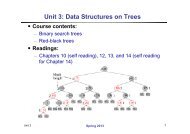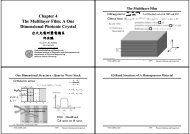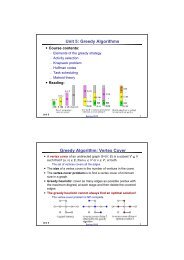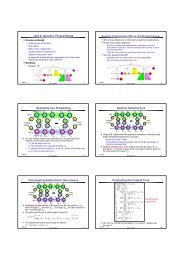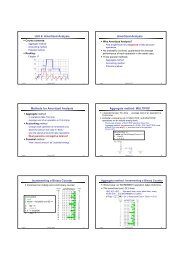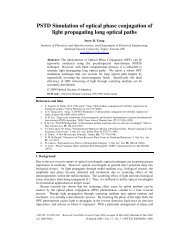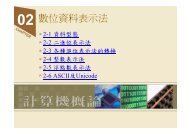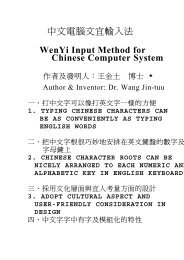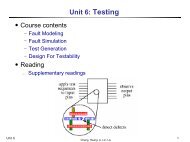Topic 3 Dielectric Waveguides and Optical Fibers 2-1 Symmetric ...
Topic 3 Dielectric Waveguides and Optical Fibers 2-1 Symmetric ...
Topic 3 Dielectric Waveguides and Optical Fibers 2-1 Symmetric ...
You also want an ePaper? Increase the reach of your titles
YUMPU automatically turns print PDFs into web optimized ePapers that Google loves.
α B (m -1 ) for 10 cm of bend<br />
10 2<br />
10 −1<br />
10 −2<br />
10 −3<br />
901 37500 光電導論 ?1999 S.O. Kasap, Optoelectronics (Prentice Hall)<br />
901 37500 光電導論<br />
10<br />
1<br />
λ = 633 nm<br />
V ≈ 2.08<br />
λ = 790 nm<br />
V ≈ 1.67<br />
0 2 4 6 8 10 12 14 16 18<br />
Radius of curvature (mm)<br />
Measured microbending loss for a 10 cm fiber bent by different amounts of radius of<br />
curvature R. Single mode fiber with a core diameter of 3.9 μm, cladding radius 48 μm,<br />
Δ = 0.004, NA = 0.11, V ≈ 1.67 <strong>and</strong> 2.08 (Data extracted <strong>and</strong> replotted with Δ correction<br />
from, A.J. Harris <strong>and</strong> P.F. Castle, IEEE J. Light Wave Technology, Vol. LT14, pp. 34-<br />
40, 1986; see original article for discussion of peaks in αB vs. R at 790 nm).<br />
77<br />
Example 2.9.1: Rayleigh scattering limit<br />
What is the attenuation due to Rayleigh scattering at around the<br />
λ = 1.55μm window given that pure silica (SiO 2 ) has the following<br />
properties: T f = 1730°C (softening temperature);<br />
β T = 7 x 10 -11 m 2 N -1 (at high temperatures);<br />
n = 1.4446 at 1.5μm.<br />
α<br />
≈<br />
3<br />
=<br />
R<br />
8π<br />
≈<br />
3λ<br />
3<br />
4<br />
2 ( n −1)<br />
3<br />
8π<br />
2 2 −11<br />
−23<br />
( 1.<br />
4446 −1)<br />
( 7×<br />
10 )( 1.<br />
38×<br />
10 )( 1.<br />
730 + 273)<br />
−6<br />
4<br />
( 1.<br />
55×<br />
10 )<br />
3.<br />
27×<br />
10<br />
−5<br />
Attenuation<br />
α<br />
dB<br />
= 4.<br />
34α<br />
m<br />
R<br />
−1<br />
=<br />
2<br />
=<br />
β<br />
T<br />
k<br />
B<br />
T<br />
3.<br />
27×<br />
10<br />
f<br />
−2<br />
km<br />
−1<br />
−2<br />
−1<br />
−1<br />
( 4.<br />
34)(<br />
3.<br />
27×<br />
10 km ) = 0.<br />
142dBkm<br />
79<br />
Example 2.9.1: Rayleigh scattering limit<br />
What is the attenuation due to Rayleigh scattering at around the<br />
λ = 1.55μm window given that pure silica (SiO 2) has the following<br />
properties: T f = 1730°C (softening temperature);<br />
β T = 7 x 10 -11 m 2 N -1 (at high temperatures);<br />
n = 1.4446 at 1.5μm.<br />
901 37500 光電導論<br />
Example 2.9.2: Attenuation along an optical fiber<br />
The optical power launched into a single-mode fiber from a laser<br />
diode is approximately 1 mW. The photodetector at the output<br />
required a minimum power of 10 nW to provide a clear signal (above<br />
noise). The fiber operates at 1.3μm <strong>and</strong> has an attenuation coefficient<br />
of 0.4 dB km -1 . What is the maximum length of fiber that can be used<br />
without inserting a repeater (to regenerate the signal)?<br />
α<br />
dB<br />
1<br />
L =<br />
α<br />
901 37500 光電導論<br />
1 ⎛ P<br />
= 10log<br />
L ⎜<br />
⎝ P<br />
dB<br />
in<br />
out<br />
⎛ P<br />
10log<br />
⎜<br />
⎝ P<br />
in<br />
out<br />
⎞<br />
⎟<br />
⎠<br />
−3<br />
⎞ 1 ⎛10<br />
⎞<br />
⎟ = 10log<br />
= 125km<br />
8<br />
0.<br />
4 ⎜<br />
10 ⎟ −<br />
⎠ ⎝ ⎠<br />
The signal has to be amplified after a distance of about 50 ~<br />
100km, <strong>and</strong> eventually regenerated by using a repeater.<br />
78<br />
80



